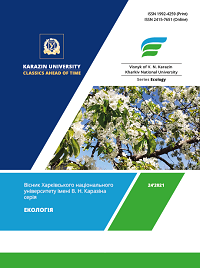Вплив гелію та кавітації на процес життєдіяльності дріжджів
Анотація
В експериментальній частині роботи запропонований процес обробки води з вмістом дріжджових клітин в кавітаційних умовах при одночасній подачі гелію. Встановлена ефективність очищення води від дріжджів в результаті об’єднаної дії гелій/кавітація. Розрахована величина ефективної константи швидкості руйнування мікроорганізмів за кінетичним рівнянням реакції першого порядку. Досліджено життєздатність дріжджів в умовах кавітації та барботуванні аргону через водну систему. Розраховано та здійснено порівняння частки загиблих клітин впродовж двогодинної дії забрудненої дріжджами води при різних режимах обробки. Встановлено активне зменшення чисельності Saccharomyces cerevisiae у водному середовищі на початку процесу з досягненням частки загиблих клітин (Dd) 40,48% після 30 хв спільної дії Не/кавітація при вихідному мікробіологічному забрудненні води 4,2·103 КУО/см3. Після 90-хвилинної обробки води ЧМкін = 100 КУО/см3, що відповідає ступеню очистки води > 97%.
Одержані результати вказують на інтенсивне кавітаційне очищення води від досліджених мікроорганізмів в умовах експерименту, що підтверджує вплив природи досліджуваного газу на процес руйнування мікробіологічних забрудників у воді. В кінцевому результаті отримано практично чисту воду, що дозволяє скидати оброблену воду у відкриті водойми.
##submission.downloads##
Опубліковано
Номер
Розділ
Ліцензія
Авторське право (c) 2021 Коваль І. З.

Ця робота ліцензується відповідно до Creative Commons Attribution 4.0 International License.
Автори, які публікуються у цьому журналі, погоджуються з наступними умовами:
- Автори залишають за собою право на авторство своєї роботи та передають журналу право першої публікації цієї роботи на умовах ліцензії Creative Commons Attribution License 4.0 International (CC BY 4.0), котра дозволяє іншим особам вільно розповсюджувати опубліковану роботу з обов'язковим посиланням на авторів оригінальної роботи та першу публікацію роботи у цьому журналі.
- Автори мають право укладати самостійні додаткові угоди щодо неексклюзивного розповсюдження роботи у тому вигляді, в якому вона була опублікована цим журналом (наприклад, розміщувати роботу в електронному сховищі установи або публікувати у складі монографії), за умови збереження посилання на першу публікацію роботи у цьому журналі.
- Політика журналу дозволяє і заохочує розміщення авторами в мережі Інтернет (наприклад, у сховищах установ або на особистих веб-сайтах) рукопису роботи, як до подання цього рукопису до редакції, так і під час його редакційного опрацювання, оскільки це сприяє виникненню продуктивної наукової дискусії та позитивно позначається на оперативності та динаміці цитування опублікованої роботи (див. The Effect of Open Access).

